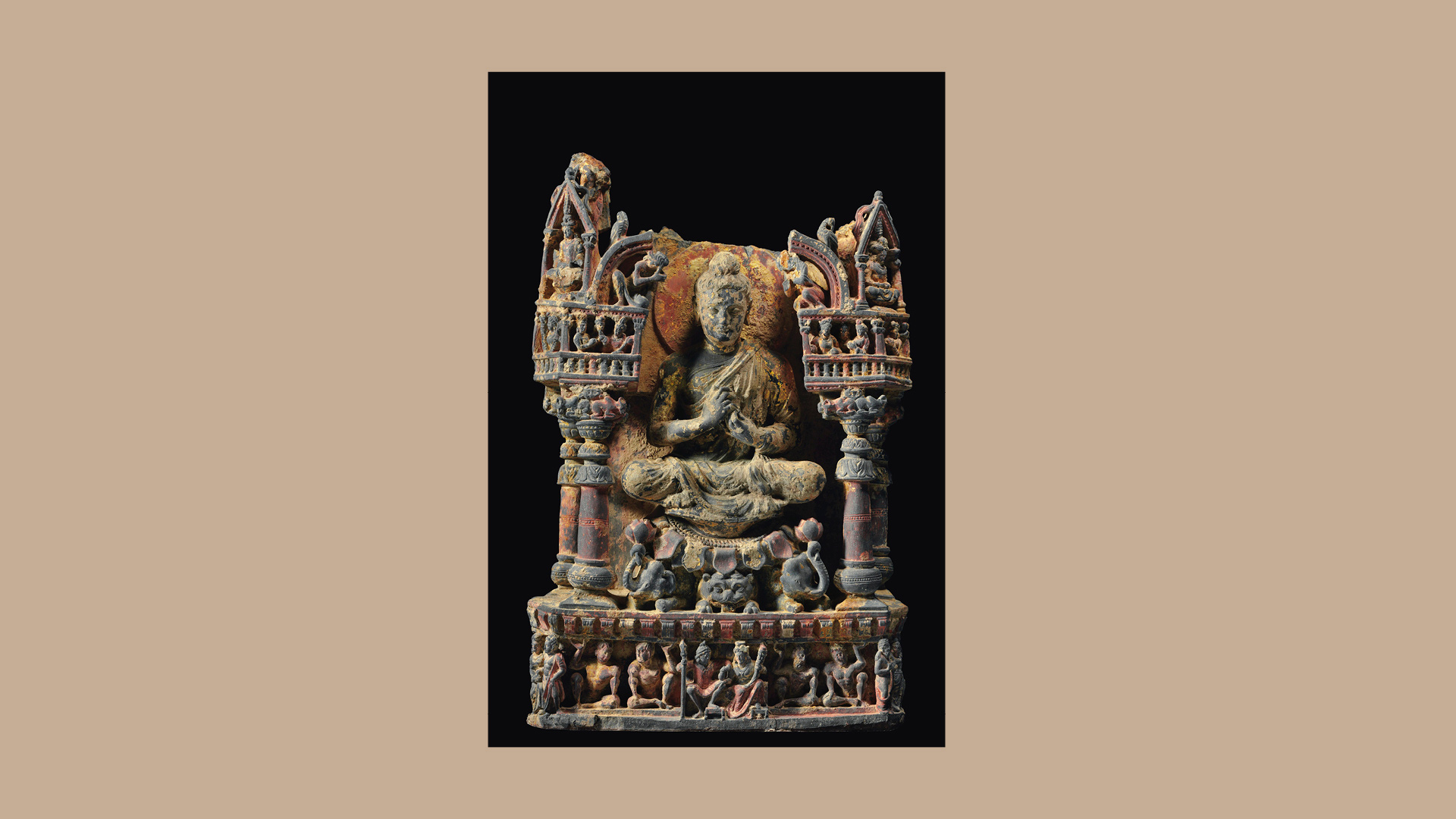Divine Women, Divine Wisdom
Selected works
Click image to enlarge in new window
-

Dancing Devi, India, Madhya or Uttar Pradesh, 12th century; Buff sandstone
A voluptuous, celestial woman, adorned with a crown and jewels around her neck and waist, turns as a dancer in space to gaze back even as her movements appear to propel her forward. The figure reaches up to grasp the fruit-bearing tree, emphasizing both her own fecundity and that of the tree. This sculpture likely originally served as a bracket within a larger architectural setting.
EL.1.07.19 -

Teaching Buddha, Gandhara, 2nd or 3rd century; Schist with traces of gilt and pigment
This sculpture illustrates the second miracle of Sravasti, wherein the Buddha performed his superiority over the Kasyapas. Seated on an inverted lotus throne supported by two elephants with a lion in the center, the Buddha holds his hands in the teaching gesture. The base depicts a frieze of Hariti, a revered goddess and protector of children in Buddhist belief. Her image is thought to be derived from that of the goddess Tyche (represented in this gallery). By her side is her consort Panchika with whom she is said to have had five hundred children. Hariti and Panchika are regarded as ideals of marital love and the dispensers of riches and fertility.
EL.3.1 2.1 -

Two Taras, Nepal, 18th Century; Gilt copper repousse
Tara is the preeminent female image in Tibetan Buddhism and is regarded as the feminine counterpart to the compassionate bodhisattva Avalokiteshvara. These seated images may represent two of the five differently colored Taras associated with the five Dhyani Buddhas. Seated in the lalitasana posture, with one leg tucked under and the other extended, both figures display the same "giving refuge" gesture in images that mirror one another. Tara is regarded as "She Who Saves,"with the ability to provide assistance to all sentient beings.
EL.1.07.21.a-b -

Prajnaparamita, Tibet, 15th Century; Gilt bronze
This female figure represents the deification of the Perfection of Wisdom Sutra, a teaching handed down from the Buddha to the Nagas for safekeeping until the time came for the faithful to accept the teaching in the first or second century. She is frequently depicted with a sutra, but in this case two of her four hands are shown in the dharma chakra, or teaching mudra, while the other two are in the dhyana,or meditation gesture. Prajnaparamita is the highest form of female deities of wisdom. Wisdom is extremely important in the Buddhist context, as it is through wisdom that one can understand the nature of reality and liberate oneself from suffering.
EL.1.07.31
Palden Lhamo, Tibet, 17th Century; Gilt bronze
Palden Lhamo is considered the protector deity for the Dalai Lama and the city of Lhasa. She is said to have appeared in a vision to the first Dalai Lama, promising to protect his reincarnation lineage at a lake ninety miles southwest of Lhasa known as Lhamo Latso.
On long-term loan from a private collection EL.1.07.30
Sarvabuddhadakini, Tibet, 19th Century; Gilt bronze
Dakini, or skywalkers, are fierce angelic deities that were originally associated with the popular Indian Hindu deity Kali. In Tibet they are associated with Tantric yogic practice. The idealized beauty of the feminine form presents a strong contrast to the image's horrific face and crown of skulls.
El.1.2007.29
Hevajra Mandala, Tibet, 14th century; Opaque pigments and gold on textile
This two-dimensional representation of a three-dimensional architectural space depicts the celestial palace of the principal meditational deity, Hevajra. Light blue in color, he is shown with multiple arms embracing his dark blue consort, Nairatmya. Goddesses of various colors are shown within a surrounding architectural framework. The large ring around the central palace structure depicts the charnel grounds in vivid detail. Images of lineage gurus line the top of the mandala while wrathful protector deities are depicted across the bottom. The donor is depicted in the lower right corner.



